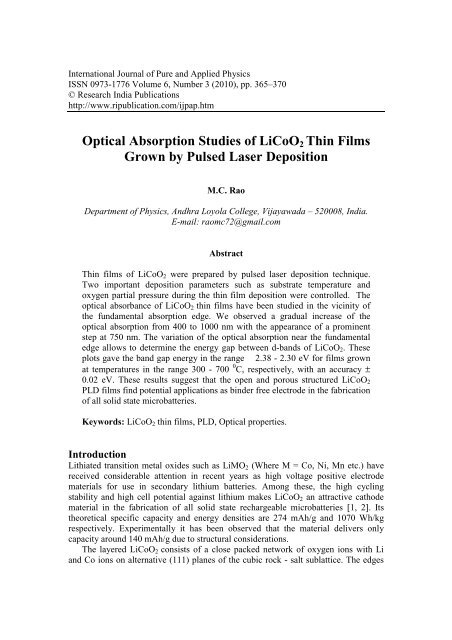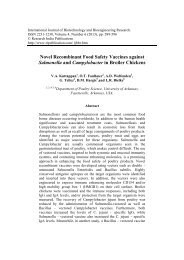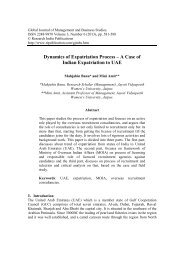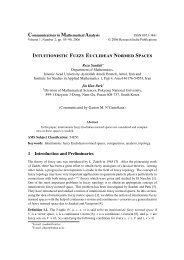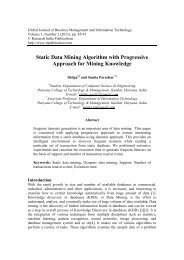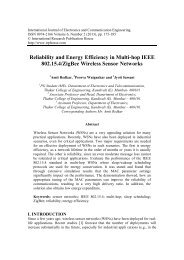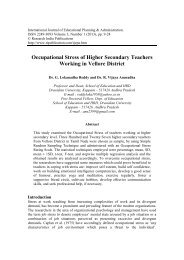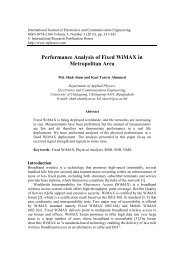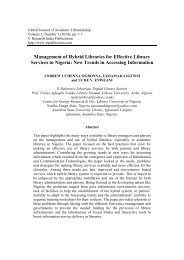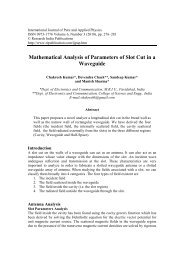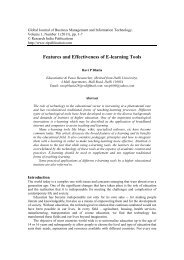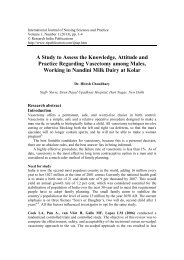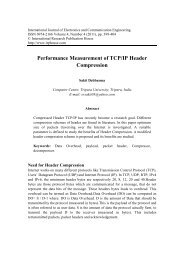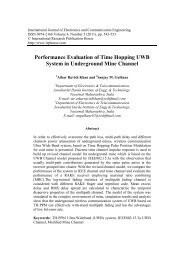Optical Absorption Studies of LiCoO2 Thin Films Grown by Pulsed ...
Optical Absorption Studies of LiCoO2 Thin Films Grown by Pulsed ...
Optical Absorption Studies of LiCoO2 Thin Films Grown by Pulsed ...
Create successful ePaper yourself
Turn your PDF publications into a flip-book with our unique Google optimized e-Paper software.
International Journal <strong>of</strong> Pure and Applied Physics<br />
ISSN 0973-1776 Volume 6, Number 3 (2010), pp. 365–370<br />
© Research India Publications<br />
http://www.ripublication.com/ijpap.htm<br />
<strong>Optical</strong> <strong>Absorption</strong> <strong>Studies</strong> <strong>of</strong> LiCoO 2 <strong>Thin</strong> <strong>Films</strong><br />
<strong>Grown</strong> <strong>by</strong> <strong>Pulsed</strong> Laser Deposition<br />
M.C. Rao<br />
Department <strong>of</strong> Physics, Andhra Loyola College, Vijayawada – 520008, India.<br />
E-mail: raomc72@gmail.com<br />
Abstract<br />
<strong>Thin</strong> films <strong>of</strong> LiCoO 2 were prepared <strong>by</strong> pulsed laser deposition technique.<br />
Two important deposition parameters such as substrate temperature and<br />
oxygen partial pressure during the thin film deposition were controlled. The<br />
optical absorbance <strong>of</strong> LiCoO 2 thin films have been studied in the vicinity <strong>of</strong><br />
the fundamental absorption edge. We observed a gradual increase <strong>of</strong> the<br />
optical absorption from 400 to 1000 nm with the appearance <strong>of</strong> a prominent<br />
step at 750 nm. The variation <strong>of</strong> the optical absorption near the fundamental<br />
edge allows to determine the energy gap between d-bands <strong>of</strong> LiCoO 2 . These<br />
plots gave the band gap energy in the range 2.38 - 2.30 eV for films grown<br />
at temperatures in the range 300 - 700 0 C, respectively, with an accuracy ±<br />
0.02 eV. These results suggest that the open and porous structured LiCoO 2<br />
PLD films find potential applications as binder free electrode in the fabrication<br />
<strong>of</strong> all solid state microbatteries.<br />
Keywords: LiCoO 2 thin films, PLD, <strong>Optical</strong> properties.<br />
Introduction<br />
Lithiated transition metal oxides such as LiMO 2 (Where M = Co, Ni, Mn etc.) have<br />
received considerable attention in recent years as high voltage positive electrode<br />
materials for use in secondary lithium batteries. Among these, the high cycling<br />
stability and high cell potential against lithium makes LiCoO 2 an attractive cathode<br />
material in the fabrication <strong>of</strong> all solid state rechargeable microbatteries [1, 2]. Its<br />
theoretical specific capacity and energy densities are 274 mAh/g and 1070 Wh/kg<br />
respectively. Experimentally it has been observed that the material delivers only<br />
capacity around 140 mAh/g due to structural considerations.<br />
The layered LiCoO 2 consists <strong>of</strong> a close packed network <strong>of</strong> oxygen ions with Li<br />
and Co ions on alternative (111) planes <strong>of</strong> the cubic rock - salt sublattice. The edges
366 M.C. Rao<br />
<strong>of</strong> CoO 6 octahedral were shared to form CoO 2 sheets and lithium ions can move in<br />
two-dimensional directions between CoO 2 sheets. Thus the layered LiCoO 2 has an<br />
anisotropic structure and there <strong>by</strong> electrochemical lithium insertion / extraction<br />
behaviour must depend strongly on the orientation <strong>of</strong> the microcrystallites. The<br />
growth <strong>of</strong> LiCoO 2 thin films with preferred orientation is known to be crucial. Several<br />
thin film deposition techniques such as RF sputtering [1, 3], pulsed laser deposition<br />
[3-7], electrostatic spray deposition [8] and chemical vapour deposition [9] were<br />
employed for the growth <strong>of</strong> LiCoO 2 thin films. A brief literature survey reveals that it<br />
is difficult to grow stoichiometric and stable c - axis oriented LiCoO 2 thin films <strong>by</strong><br />
several physical vapour deposition methods due to many growth kinetic processes<br />
which occur in vacuum or at low oxygen partial pressures.<br />
Recently, pulsed laser deposition (PLD) has been widely recognized as a very<br />
promising, versatile and efficient method for the deposition <strong>of</strong> metal oxide thin films<br />
[10]. When PLD is carried out in the atmosphere <strong>of</strong> a chemically reactive gas<br />
(a process known as reactive pulsed laser deposition (RPLD)), the flux <strong>of</strong> the laser<br />
ablated material interacts with the gas molecules all along the transit from the target to<br />
the collector surface. The resulting deposited layer was found to have a chemical<br />
composition substantially the same as the base or starting material. Preliminary<br />
investigations on pulsed laser deposited LiCoO 2 thin films were carried out <strong>by</strong><br />
Julien et al. [4]. Iriyama et al. [5] prepared thin films <strong>of</strong> LiCoO 2 <strong>by</strong> PLD and studied<br />
the electrochemical performance. They observed that the reactivity in single-phase<br />
region at potentials more positive than 4.0 V was lower than that <strong>of</strong> randomly oriented<br />
films. Poly-crystalline layered R 3m<br />
phase thin films <strong>of</strong> LiCoO 2 were grown <strong>by</strong> PLD<br />
<strong>by</strong> Julien et al. [11]. These LiCoO 2 cathode active films were found to deliver a<br />
specific capacity <strong>of</strong> 195 mC/μm cm 2 in the voltage range 2.0 - 4.2 V. However the<br />
investigations on the physical properties <strong>of</strong> LiCoO 2 films that are essentially depend<br />
upon the deposition parameters give a scope for effective utilization <strong>of</strong> these thin<br />
films in the fabrication <strong>of</strong> microbatteries. Hence in the present study the influence <strong>of</strong><br />
deposition parameters on the optical properties <strong>of</strong> pulsed laser deposited LiCoO 2 thin<br />
films were reported.<br />
Experimental<br />
LiCoO 2 films were grown <strong>by</strong> pulsed laser deposition technique on quartz substrates<br />
maintained at temperatures in the range 300 - 700 0 C. LiCoO 2 target was prepared <strong>by</strong><br />
sintering a mixture <strong>of</strong> high purity LiCoO 2 and Li 2 O powders (Cerac products) with<br />
excess <strong>of</strong> Li i.e. Li/Co > 1.0 <strong>by</strong> adding Li 2 O [11]. The mixture was crushed and<br />
pressed at 5 tonns.cm -2 to make tablets <strong>of</strong> 2 mm thick and 13 mm diameter. To get<br />
quite robust targets, the tablets were sintered in air at 800 0 C. The typical substrates<br />
i.e. quartz glass were cleaned using HF solution. The target was rotated at 10 rotations<br />
per minute with an electric motor to avoid depletion <strong>of</strong> material at any given spot. The<br />
laser used in these experiments is the 248 nm line <strong>of</strong> a KrF excimer laser (Luminics<br />
PM 882) with 10 ns pulse with a repetition rate <strong>of</strong> 10 Hz. The rectangular spot size <strong>of</strong><br />
the laser pulse was 1x3 mm and the energy 300 mJ. The target substrate distance was<br />
4 cm. The deposition temperature was maintained with thermocouple and temperature
<strong>Optical</strong> <strong>Absorption</strong> <strong>Studies</strong> <strong>of</strong> LiCoO 2 <strong>Thin</strong> <strong>Films</strong> <strong>Grown</strong> 367<br />
controller. During the deposition pure oxygen was introduced into the deposition<br />
chamber and desired pressure was maintained with a flow controller. The optical<br />
properties <strong>of</strong> the films were recorded using Hitachi U 3400 UV-VIS-NIR double<br />
beam spectrophotometer with accuracy limits ± 0.2 nm.<br />
Results and Discussion<br />
<strong>Pulsed</strong> laser deposited LiCoO 2 films are pin-hole free as revealed from optical<br />
microscopy and well adherent to the substrate surface. The thickness <strong>of</strong> LiCoO 2 films<br />
is 250 nm. The influence <strong>of</strong> oxygen partial pressure (pO 2) and deposition temperature<br />
(Ts) on the optical properties <strong>of</strong> the films is systematically studied. The chemical<br />
compositional studies made on LiCoO 2 films revealed that a minimum <strong>of</strong> 100 mTorr<br />
oxygen partial pressure is required to grow nearly stoichiometric films.<br />
The study <strong>of</strong> optical absorption, particularly the absorption edge, has proved to be<br />
very useful for elucidation <strong>of</strong> the electronic structure <strong>of</strong> the materials. It is possible to<br />
determine whether the optically induced transition is direct or indirect and allowed or<br />
forbidden <strong>by</strong> analysis <strong>of</strong> the absorption edge.<br />
The optical absorption coefficient <strong>of</strong> the films is evaluated using the relation<br />
α = 1/t ln (T/(1-R) 2 ) (1)<br />
Where T is the transmittance, R is the reflectance and t the thickness <strong>of</strong> the film.<br />
For an incident photon energy greater than the band gap and above the<br />
exponential tail the optical absorption follows a power law [12] <strong>of</strong> the form<br />
α(hv) = B(hv - E g ) n (2)<br />
Where B is a constant, E g is the band gap <strong>of</strong> the material and n is the exponent.<br />
The exponent n determines the type <strong>of</strong> electronic transition causing the absorption and<br />
take the values 1/2, 3/2, 2 and 3 for direct allowed, direct forbidden, indirect allowed<br />
and indirect forbidden transitions respectively [13].<br />
The optical absorbance <strong>of</strong> LiCoO 2 thin films have been studied in the vicinity <strong>of</strong><br />
the fundamental absorption edge. The electronic structure <strong>of</strong> the Co-3d bands <strong>of</strong><br />
layered rock salt LiCoO 2 consists <strong>of</strong> three Co-t 2g (valence bands) and two Co-e g<br />
(conduction bands). Theoretical investigations have shown that the Co-e g bands are<br />
empty and their peak position lies at around 1.7 eV above the top to the Co-t 2g bands<br />
[14]. The density <strong>of</strong> states due to the Co-e g bands consist <strong>of</strong> a prominent peak at ~2.2<br />
eV above the Fermi level E F in the Co-t 2g band [15].<br />
Fig. 1 shows the optical absorption spectra related in the wavelength range 300-<br />
1200 nm for the films deposited at substrate temperatures 300 and 700 0 C on quartz<br />
substrate. We observed a gradual increase <strong>of</strong> the optical absorption from 400 to 1000<br />
nm with the appearance <strong>of</strong> a prominent step at 750 nm. This feature is more<br />
pronounced for the well-crystallized film grown at 700 0 C. Plots <strong>of</strong> the optical<br />
absorbance, (αhν) 2 versus photon energy for LiCoO 2 films are shown in Fig. 2.<br />
The variation <strong>of</strong> the optical absorption near the fundamental edge allows to<br />
determine the energy gap between d-bands <strong>of</strong> LiCoO 2 . These plots gave the band gap<br />
energy in the range 2.38 - 2.30 eV for films grown at temperatures in the range<br />
300 - 700 0 C, respectively, with an accuracy ± 0.02 eV. These results are in good<br />
agreement with theoretical estimations [14, 15] and experimental data reported <strong>by</strong>
368 M.C. Rao<br />
Kushida and Kuriyama[13]. The d-d transition from E F in the Co-t 2g bands to the Coe<br />
g bands in LiCoO 2 was observed at 2.1 eV. Intercalation <strong>of</strong> Li in LiCoO 2 increases<br />
the Co-O bond length leading to a σ overlap between the O-2p and Co-3d orbitals,<br />
there<strong>by</strong> pushing the antibonding bands (e g bands) down [15]. Thus the textured films<br />
allow for investigation <strong>of</strong> the d-d electronic transition in LiCoO 2 . Our experimental<br />
data support the above theoretical prediction.<br />
Figure 1: <strong>Optical</strong> absorption spectra <strong>of</strong> LiCoO 2 deposited at different substrate<br />
temperatures in pO 2 = 100 mTorr.<br />
Figure 2: Plots <strong>of</strong> (αhν) 2 vs. hν <strong>of</strong> LiCoO 2 thin film deposited at different substrate<br />
temperatures in pO 2 = 100 mTorr.
<strong>Optical</strong> <strong>Absorption</strong> <strong>Studies</strong> <strong>of</strong> LiCoO 2 <strong>Thin</strong> <strong>Films</strong> <strong>Grown</strong> 369<br />
Conclusion<br />
<strong>Thin</strong> films <strong>of</strong> LiCoO 2 were prepared <strong>by</strong> pulsed laser deposition. PLD films were<br />
found to be uniform with regard to the surface topography, thickness and well<br />
adherent to the substrate surface. The optical absorbance <strong>of</strong> LiCoO 2 thin films have<br />
been studied in the vicinity <strong>of</strong> the fundamental absorption edge. The variation <strong>of</strong> the<br />
optical absorption near the fundamental edge allows to determine the energy gap<br />
between d-bands <strong>of</strong> LiCoO 2 . The band gap energy was measured in the range<br />
2.38 - 2.30 eV for films grown at temperatures in the range 300 - 700 0 C, respectively,<br />
with an accuracy ± 0.02 eV. These results suggest that the open and porous structured<br />
LiCoO 2 PLD films find potential applications as binder free electrode in the<br />
fabrication <strong>of</strong> all solid state microbatteries.<br />
References<br />
[1] Neudecker, B.J., Dudney, N.J. and Bates, J.B., 2000, “Lithium free thin film<br />
battery with insitu plated Li anode,” J. Electrochem. Soc., 147, pp. 517-523.<br />
[2] Bates, J.B., Dudney, N.J., Neudecker, B., Veda, A. and Evans, C.D., 2000,<br />
“<strong>Thin</strong> film lithium and lithium ion batteries,” Solid State Ionics, 135, pp. 33-<br />
45.<br />
[3] Bouwman, P.J., Boukamp, B.A., Bouwmeester, H.J.M. and Notten, P.H.L.,<br />
2002, “Structure related interclation behavior <strong>of</strong> LiCoO 2 films,” Solid State<br />
Ionics, 152, pp. 181-188.<br />
[4] Julien, C., Haro-Poniatowski, E., Hussain, O.M. and Ramana, C.V., 2001,<br />
“Structure and electrochemistry <strong>of</strong> thin film oxide grown <strong>by</strong> pulsed laser<br />
deposition,” Ionics, 7, pp. 165-171.<br />
[5] Iriyama, Y., Inabu, T., Abe, T. and Ogumi, Z., 2001, “Preparation <strong>of</strong> c-axis<br />
oriented thin films <strong>of</strong> LiCoO 2 <strong>by</strong> pulsed laser deposition and their<br />
electrochemical properties,” J. Power Sources, 94, pp. 175-182.<br />
[6] Xia, H., Lu, L. and Ceder, G., 2006, “Li diffusion in LiCoO 2 thin films<br />
prepared <strong>by</strong> pulsed laser deposition,” J. Power Sources, 159, pp. 1422-1427.<br />
[7] Tang, S.B., Lai, M.O. and Lu, L., 2008,”Li-ion diffusion in highly (0 0 3)<br />
oriented LiCoO 2 thin film cathode prepared <strong>by</strong> pulsed laser deposition,” J.<br />
Alloys compds., 449, pp. 300-303.<br />
[8] Chen, C.H., Buysman, A.A.J., Kelder, E.M. and Schoonman, J., 1995,<br />
“Fabrication <strong>of</strong> LiCoO 2 thin film cathodes for rechargeable lithium battery <strong>by</strong><br />
electrostatic spray pyrolysis,” Solid State Ionics, 80, pp. 1-4.<br />
[9] Chai, G. and Yoon, S.G., 2004, “Structural and electrical properties <strong>of</strong> LiCoO 2<br />
thin film cathodes deposited on planar and trench structures <strong>by</strong> liquid-delivery<br />
metal organic chemical vapour deposition,” J. Power Sources, 125, pp. 236-<br />
241.<br />
[10] Miller, J. C. and Haglmel, R. F., 1998, “JR., Laser Ablation and Deposition,”<br />
Academic Press, New York.
370 M.C. Rao<br />
[11] Julien, C., Camacho-Lopez, M.A., Escobar-Alarcon, L. and Haro-<br />
Poniatowski, E., 2001,“Fabrication <strong>of</strong> LiCoO 2 thin film cathodes for<br />
rechargeable lithium microbatteries,” Mater. Chem. Phys., 68, pp. 210-216.<br />
[12] Aydinol, M.T., Kohan, A.F., Ceder, Cho, G.K. and Joannopoulos, J., 1997,<br />
“Ab initio study <strong>of</strong> lithium intercalation in metal oxides and metal<br />
dichalcogenides,” Phys. Rev. B, 56, pp. 1354- 1365.<br />
[13] Kushida, K. and Kuriyama, K., 2001, “<strong>Optical</strong> absorption related to Co-3d<br />
bands in sol-gel grown LiCoO 2 thin films,” Solid State Commun., 118, pp.<br />
615-618.<br />
[14] Van Elp, J., Wieland, J.L., Eskes, H., Kuiper, P., Sawatzky, G.A., De Groot,<br />
F.M.F. and Turner, T.S., 1992,” The electronic structure <strong>of</strong> CoO 2 Li doped<br />
CoO and CoO 2 ,” Phys. Rev. B, 44, pp. 6090-6103.<br />
[15] Ohzuku, T. and Ueda, A., 1994, “Electrochemical properties <strong>of</strong> LiNiO 2<br />
cathode material synthesized <strong>by</strong> the emulsion method,” Solid State Ionics, 69,<br />
pp. 201- 211.


